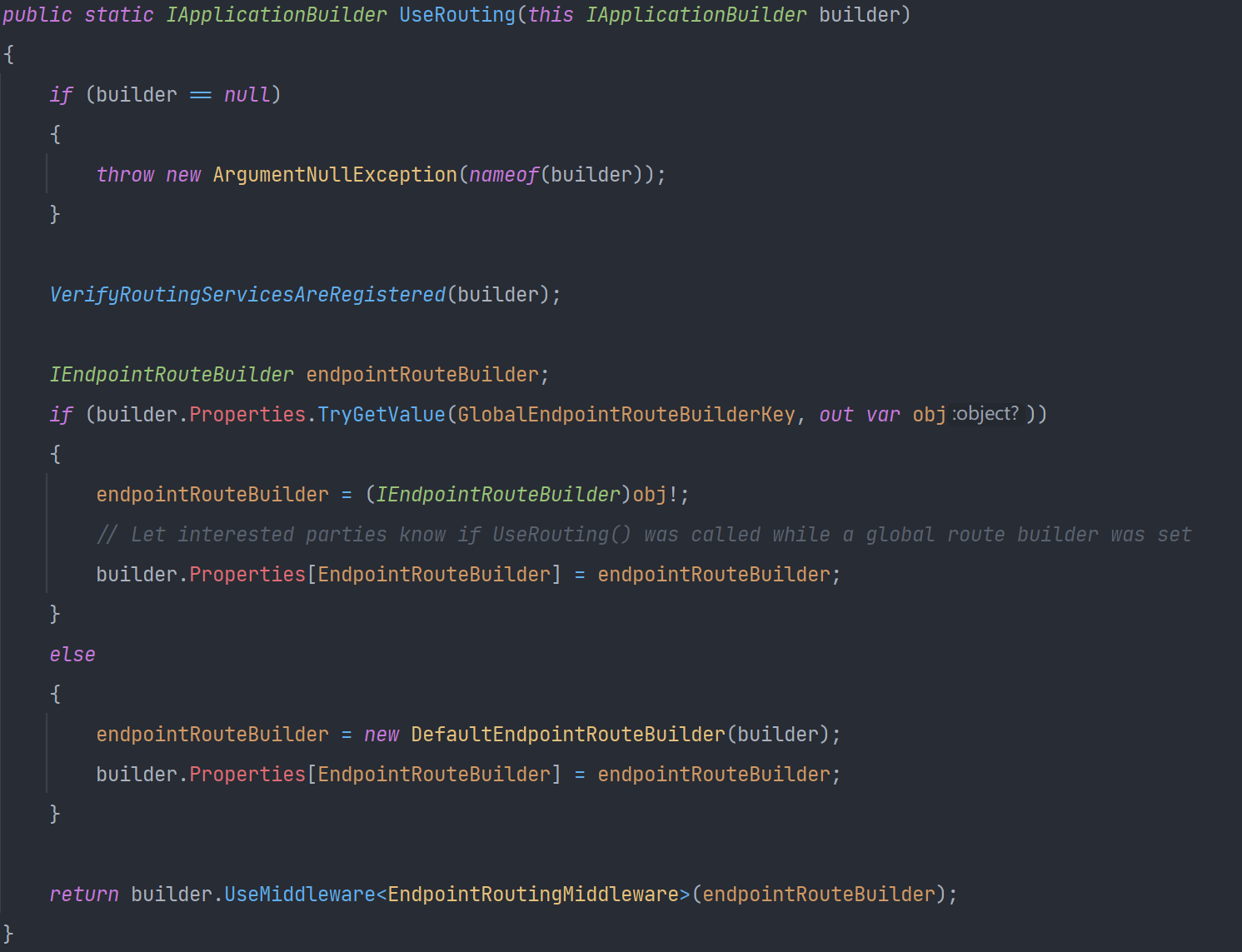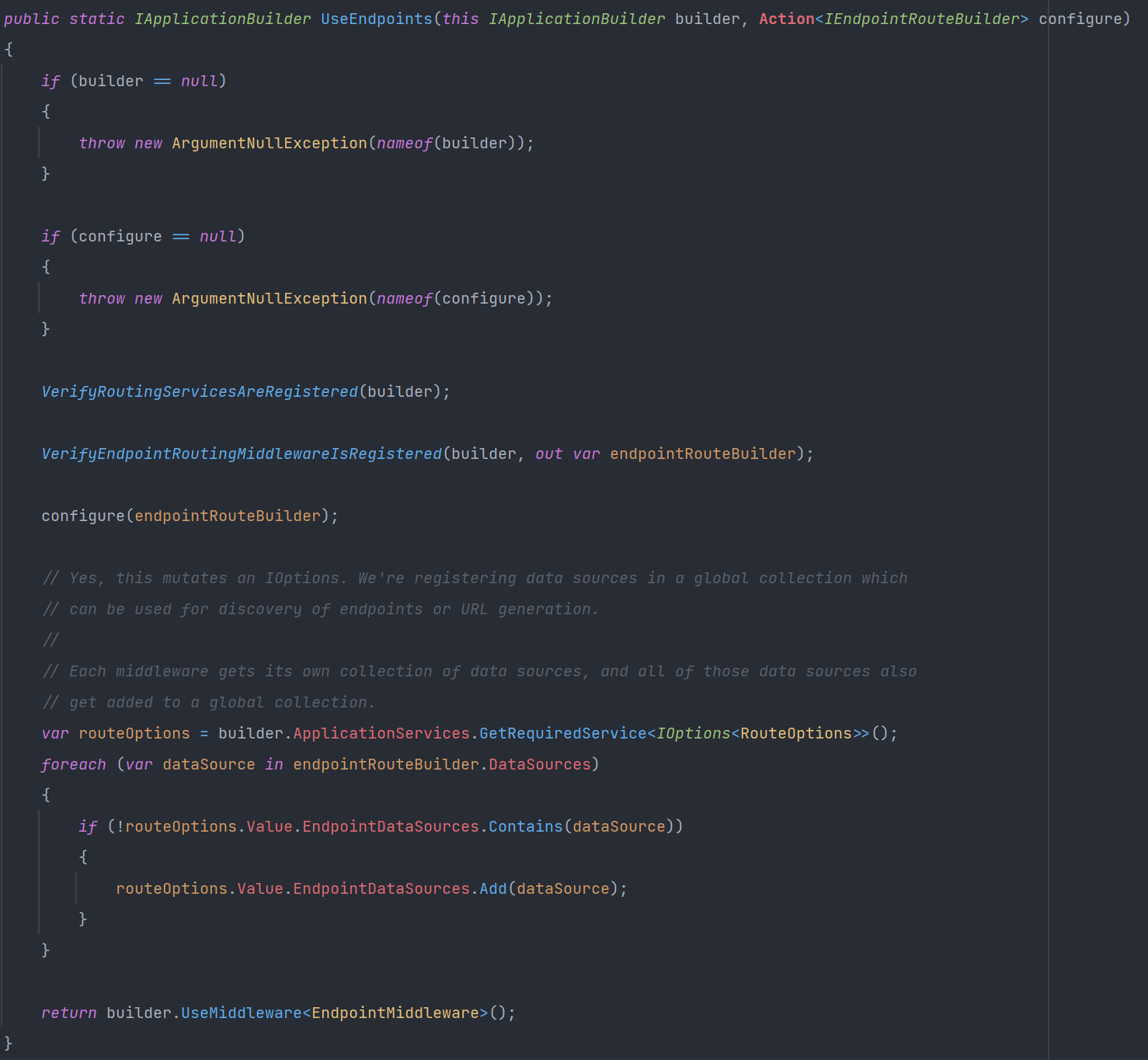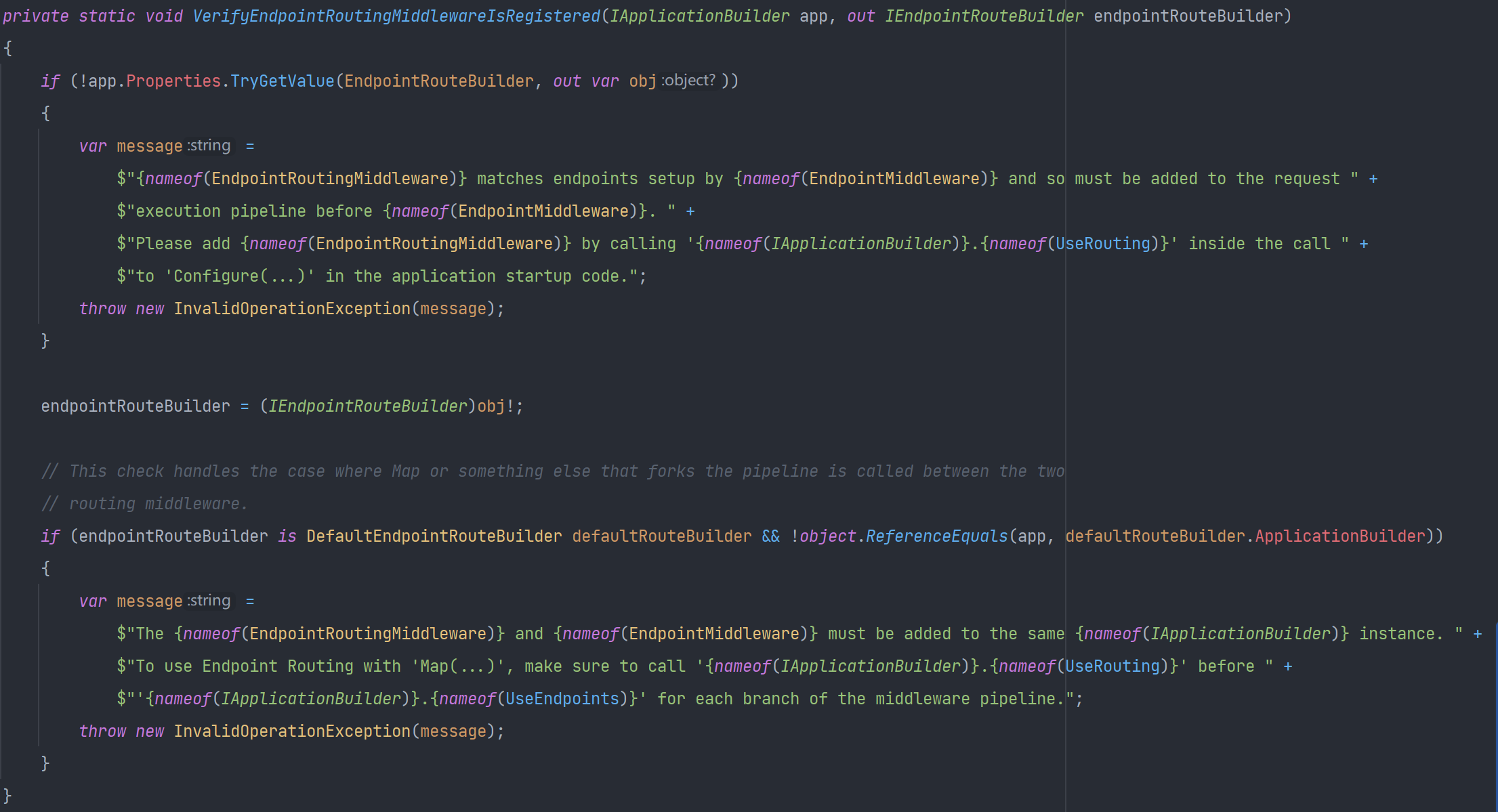.Net Core後端架構實戰【2-實現動態路由與Dynamic API】
摘要:基於.NET Core 7.0WebApi後端架構實戰【2-實現動態路由與Dynamic API】 2023/02/22, ASP.NET Core 7.0, VS2022
引言
使用過ABP vNext和Furion框架的可能都會對它們的動態API感到好奇,不用手動的去定義,它會動態的去建立API控制器。後端程式碼
架構的複雜在核心程式碼,如果這些能封裝的好提升的是小組整體的生產力。靈圖圖書的扉頁都會有這樣一句話:"站在巨人的肩膀上"。我在
這裡大言不慚的說上一句我希望我也能成為"巨人"!
動態路由
在.Net Core WebAPI程式中通過可全域性或區域性修改的自定義Route屬性和URL對映元件匹配傳入的HTTP請求替代預設路由即為動態路由
WebApplicationBuilder
在3.1以及5.0的版本中,Configure方法中會自動新增UseRouting()與UseEndpoints()方法,但是在6.0以上版本已經沒有了。其實在建立WebApplicationBuilder範例的時候預設已經新增進去了。請看原始碼:
var builder = WebApplication.CreateBuilder(args);/// <summary>
/// Initializes a new instance of the class with preconfigured defaults.
/// </summary>
/// <param name="args">Command line arguments</param>
/// <returns>The <see cref="WebApplicationBuilder"/>.</returns>
public static WebApplicationBuilder CreateBuilder(string[] args) =>
new(new WebApplicationOptions() { Args = args });
internal WebApplicationBuilder(WebApplicationOptions options, Action? configureDefaults = null)
{
Services = _services;
var args = options.Args;
// Run methods to configure both generic and web host defaults early to populate config from appsettings.json
// environment variables (both DOTNET_ and ASPNETCORE_ prefixed) and other possible default sources to prepopulate
// the correct defaults.
_bootstrapHostBuilder = new BootstrapHostBuilder(Services, _hostBuilder.Properties);
// Don't specify the args here since we want to apply them later so that args
// can override the defaults specified by ConfigureWebHostDefaults
_bootstrapHostBuilder.ConfigureDefaults(args: null);
// This is for testing purposes
configureDefaults?.Invoke(_bootstrapHostBuilder);
// We specify the command line here last since we skipped the one in the call to ConfigureDefaults.
// The args can contain both host and application settings so we want to make sure
// we order those configuration providers appropriately without duplicating them
if (args is { Length: > 0 })
{
_bootstrapHostBuilder.ConfigureAppConfiguration(config =>
{
config.AddCommandLine(args);
});
}
_bootstrapHostBuilder.ConfigureWebHostDefaults(webHostBuilder =>
{
// Runs inline.
//看這裡
webHostBuilder.Configure(ConfigureApplication);
// Attempt to set the application name from options
options.ApplyApplicationName(webHostBuilder);
});
// Apply the args to host configuration last since ConfigureWebHostDefaults overrides a host specific setting (the application n
_bootstrapHostBuilder.ConfigureHostConfiguration(config =>
{
if (args is { Length: > 0 })
{
config.AddCommandLine(args);
}
// Apply the options after the args
options.ApplyHostConfiguration(config);
});
Configuration = new();
// This is chained as the first configuration source in Configuration so host config can be added later without overriding app c
Configuration.AddConfiguration(_hostConfigurationManager);
// Collect the hosted services separately since we want those to run after the user's hosted services
_services.TrackHostedServices = true;
// This is the application configuration
var (hostContext, hostConfiguration) = _bootstrapHostBuilder.RunDefaultCallbacks(Configuration, _hostBuilder);
// Stop tracking here
_services.TrackHostedServices = false;
// Capture the host configuration values here. We capture the values so that
// changes to the host configuration have no effect on the final application. The
// host configuration is immutable at this point.
_hostConfigurationValues = new(hostConfiguration.AsEnumerable());
// Grab the WebHostBuilderContext from the property bag to use in the ConfigureWebHostBuilder
var webHostContext = (WebHostBuilderContext)hostContext.Properties[typeof(WebHostBuilderContext)];
// Grab the IWebHostEnvironment from the webHostContext. This also matches the instance in the IServiceCollection.
Environment = webHostContext.HostingEnvironment;
Logging = new LoggingBuilder(Services);
Host = new ConfigureHostBuilder(hostContext, Configuration, Services);
WebHost = new ConfigureWebHostBuilder(webHostContext, Configuration, Services);
Services.AddSingleton(_ => Configuration);
}
private void ConfigureApplication(WebHostBuilderContext context, IApplicationBuilder app)
{
Debug.Assert(_builtApplication is not null);
// UseRouting called before WebApplication such as in a StartupFilter
// lets remove the property and reset it at the end so we don't mess with the routes in the filter
if (app.Properties.TryGetValue(EndpointRouteBuilderKey, out var priorRouteBuilder))
{
app.Properties.Remove(EndpointRouteBuilderKey);
}
if (context.HostingEnvironment.IsDevelopment())
{
app.UseDeveloperExceptionPage();
}
// Wrap the entire destination pipeline in UseRouting() and UseEndpoints(), essentially:
// destination.UseRouting()
// destination.Run(source)
// destination.UseEndpoints()
// Set the route builder so that UseRouting will use the WebApplication as the IEndpointRouteBuilder for route matching
app.Properties.Add(WebApplication.GlobalEndpointRouteBuilderKey, _builtApplication);
// Only call UseRouting() if there are endpoints configured and UseRouting() wasn't called on the global route builder already
if (_builtApplication.DataSources.Count > 0)
{
// If this is set, someone called UseRouting() when a global route builder was already set
if (!_builtApplication.Properties.TryGetValue(EndpointRouteBuilderKey, out var localRouteBuilder))
{
//新增路由中介軟體
app.UseRouting();
}
else
{
// UseEndpoints will be looking for the RouteBuilder so make sure it's set
app.Properties[EndpointRouteBuilderKey] = localRouteBuilder;
}
}
// Wire the source pipeline to run in the destination pipeline
app.Use(next =>
{
_builtApplication.Run(next);
return _builtApplication.BuildRequestDelegate();
});
if (_builtApplication.DataSources.Count > 0)
{
// We don't know if user code called UseEndpoints(), so we will call it just in case, UseEndpoints() will ignore duplicate DataSources
//新增終結點中介軟體
app.UseEndpoints(_ => { });
}
// Copy the properties to the destination app builder
foreach (var item in _builtApplication.Properties)
{
app.Properties[item.Key] = item.Value;
}
// Remove the route builder to clean up the properties, we're done adding routes to the pipeline
app.Properties.Remove(WebApplication.GlobalEndpointRouteBuilderKey);
// reset route builder if it existed, this is needed for StartupFilters
if (priorRouteBuilder is not null)
{
app.Properties[EndpointRouteBuilderKey] = priorRouteBuilder;
}
}public IWebHostBuilder Configure(Action<WebHostBuilderContext, IApplicationBuilder> configure)
{
var startupAssemblyName = configure.GetMethodInfo().DeclaringType!.Assembly.GetName().Name!;
UseSetting(WebHostDefaults.ApplicationKey, startupAssemblyName);
// Clear the startup type
_startupObject = configure;
_builder.ConfigureServices((context, services) =>
{
if (object.ReferenceEquals(_startupObject, configure))
{
services.Configure(options =>
{
var webhostBuilderContext = GetWebHostBuilderContext(context);
options.ConfigureApplication = app => configure(webhostBuilderContext, app);
});
}
});
return this;
}
private static WebHostBuilderContext GetWebHostBuilderContext(HostBuilderContext context)
{
if (!context.Properties.TryGetValue(typeof(WebHostBuilderContext), out var contextVal))
{
var options = new WebHostOptions(context.Configuration, Assembly.GetEntryAssembly()?.GetName().Name ?? string.Empty);
var webHostBuilderContext = new WebHostBuilderContext
{
Configuration = context.Configuration,
HostingEnvironment = new HostingEnvironment(),
};
webHostBuilderContext.HostingEnvironment.Initialize(context.HostingEnvironment.ContentRootPath, options);
context.Properties[typeof(WebHostBuilderContext)] = webHostBuilderContext;
context.Properties[typeof(WebHostOptions)] = options;
return webHostBuilderContext;
}
// Refresh config, it's periodically updated/replaced
var webHostContext = (WebHostBuilderContext)contextVal;
webHostContext.Configuration = context.Configuration;
return webHostContext;
}
UseRouting
原始碼如下圖所示:

①erifyRoutingServicesAreRegistered用於驗證路由服務是否已註冊到容器內部
②判斷在請求管道的共用資料字典的Properties中是否有GlobalEndpointRouteBuilderKey的鍵,如果沒有則New一個新的終結點路由構建者物件,並將EndpointRouteBuilder新增到共用字典中。後面UseEndpoints(Action<IEndpointRouteBuilder> configure)執行時,會將前面New的DefaultEndpointRouteBuilder 範例取出,並進一步設定它: configure(EndpointRouteBuilder範例)
③將EndpointRoutingMiddleware中介軟體註冊到管道中,該中介軟體根據請求和Url匹配最佳的Endpoint,然後將該終結點交由EndpointMiddleware 處理。
UseEndpoints
原始碼如下圖所示:

①VerifyEndpointRoutingMiddlewareIsRegistered方法將EndpointRouteBuilder從請求管道的共用字典中取出,如果沒有則說明之前沒有呼叫UseRouting(),所以呼叫UseEndpoints()之前要先呼叫UseRouting(),VerifyEndpointRoutingMiddlewareIsRegistered方法如下圖所示:

②EndpointMiddleware主要是在EndpointRoutingMiddleware篩選出endpoint之後,呼叫該endpoint的endpoint.RequestDelegate(httpContext)進行請求處理。並且這個中介軟體會最終執行RequestDelegate委託來處理請求。請求的處理大部分功能在中介軟體EndpointRoutingMiddleware中,它有個重要的屬性_endpointDataSource儲存了上文中初始化階段生成的MvcEndpointDataSource,而中介軟體EndpointMiddleware的功能比較簡單,主要是在EndpointRoutingMiddleware篩選出endpoint之後,呼叫該endpoint.RequestDelegate(httpContext)方法進行請求處理。
看一下Endpoint類原始碼,Endpoint就是定義誰(Action)來執行請求的物件
public class Endpoint
{
///<summary>
/// Creates a new instance of.
///</summary>
///<param name="requestDelegate">The delegate used to process requests for the endpoint.</param>
///<param name="metadata">
/// The endpoint <see cref="EndpointMetadataCollection"/>. May be null.
///</param>
///<param name="displayName">
/// The informational display name of the endpoint. May be null.
/// </param>
public Endpoint(
RequestDelegate? requestDelegate,
EndpointMetadataCollection? metadata,
string? displayName)
{
// All are allowed to be null
RequestDelegate = requestDelegate;
Metadata = metadata ?? EndpointMetadataCollection.Empty;
DisplayName = displayName;
}
/// <summary>
/// Gets the informational display name of this endpoint.
/// </summary>
public string? DisplayName { get; }
/// <summary>
/// Gets the collection of metadata associated with this endpoint.
///
public EndpointMetadataCollection Metadata { get; }
/// <summary>
/// Gets the delegate used to process requests for the endpoint.
/// </summary>
public RequestDelegate? RequestDelegate { get; }
/// <summary>
/// Returns a string representation of the endpoint.
/// </summary>
public override string? ToString() => DisplayName ?? base.ToString();
}
Metadata非常重要,是存放控制器還有Action的後設資料,在應用程式啟動的時候就將控制器和Action的關鍵資訊給存入,例如路由、特性、HttpMethod等
RequestDelegate 用於將請求(HttpContext)交給資源(Action)執行
AddControllers
我們來看下AddControllers()和AddMvcCore()及相關聯的原始碼
MvcServiceCollectionExtensions檔案中,AddControllersCore方法用於新增控制器的核心服務,它最主要的作用是主要作用就是掃描所有的有關程式集封裝成ApplicationPart。
public static class MvcServiceCollectionExtensions
{
/// <summary>
/// Adds services for controllers to the specified. This method will not
/// register services used for views or pages.
/// </summary>
///<param name="services">The <see cref="IServiceCollection" /> to add services to.</param>
/// <returns>An <see cref="IMvcBuilder"/> that can be used to further configure the MVC services.</returns>
/// <remarks>
/// <para>
/// This method configures the MVC services for the commonly used features with controllers for an API. This
/// combines the effects of <see cref="MvcCoreServiceCollectionExtensions.AddMvcCore(IServiceCollection)"/>,
/// <see cref="MvcApiExplorerMvcCoreBuilderExtensions.AddApiExplorer(IMvcCoreBuilder)"/>,
/// <see cref="MvcCoreMvcCoreBuilderExtensions.AddAuthorization(IMvcCoreBuilder)"/>,
/// <see cref="MvcCorsMvcCoreBuilderExtensions.AddCors(IMvcCoreBuilder)"/>,
/// <see cref="MvcDataAnnotationsMvcCoreBuilderExtensions.AddDataAnnotations(IMvcCoreBuilder)"/>,
/// and <see cref="MvcCoreMvcCoreBuilderExtensions.AddFormatterMappings(IMvcCoreBuilder)"/>.
/// </para>
/// <para>
/// To add services for controllers with views call <see cref="AddControllersWithViews(IServiceCollection)"/>
/// on the resulting builder.
/// </para>
/// <para>
/// To add services for pages call <see cref="AddRazorPages(IServiceCollection)"/>
/// on the resulting builder.
/// on the resulting builder.
/// </remarks>
public static IMvcBuilder AddControllers(this IServiceCollection services)
{
if (services == null)
{
throw new ArgumentNullException(nameof(services));
}
//新增Controllers核心服務
var builder = AddControllersCore(services);
return new MvcBuilder(builder.Services, builder.PartManager);
}
private static IMvcCoreBuilder AddControllersCore(IServiceCollection services)
{
// This method excludes all of the view-related services by default.
var builder = services
.AddMvcCore()//這個是核心,返回IMvcCoreBuilder物件,其後的服務引入都是基於它的
.AddApiExplorer()
.AddAuthorization()
.AddCors()
.AddDataAnnotations()
.AddFormatterMappings();
if (MetadataUpdater.IsSupported)
{
services.TryAddEnumerable(
ServiceDescriptor.Singleton<IActionDescriptorChangeProvider, HotReloadService>());
}
return builder;
}
}
AddMvcCore方法用於新增MVC的核心服務,下面的GetApplicationPartManager方法先獲取ApplicationPartManager物件,然後將當前程式集封裝成了ApplicationPart放進ApplicationParts集合中。ConfigureDefaultFeatureProviders(partManager)主要作用是建立了一個新的ControllerFeatureProvider範例放進了partManager的FeatureProviders屬性中,注意這個ControllerFeatureProvider物件在後面遍歷ApplicationPart的時候負責找出裡面的Controller。AddMvcCore()方法其後是新增Routing服務再接著新增Mvc核心服務然後構建一個MvcCoreBuilder範例並返回
///<summary>
/// Extension methods for setting up essential MVC services in an.
///</summary>
public static class MvcCoreServiceCollectionExtensions
{
///<summary>
/// Adds the minimum essential MVC services to the specified
/// <see cref="IServiceCollection" />. Additional services
/// including MVC's support for authorization, formatters, and validation must be added separately
/// using the <see cref="IMvcCoreBuilder"/> returned from this method.
///</summary>
///<param name="services">The <see cref="IServiceCollection" /> to add services to.</param>
/// <returns>
/// An <see cref="IMvcCoreBuilder"/> that can be used to further configure the MVC services.
/// </returns>
/// <remarks>
/// The <see cref="MvcCoreServiceCollectionExtensions.AddMvcCore(IServiceCollection)"/>
/// approach for configuring
/// MVC is provided for experienced MVC developers who wish to have full control over the
/// set of default services
/// registered. <see cref="MvcCoreServiceCollectionExtensions.AddMvcCore(IServiceCollection)"/>
/// will register
/// the minimum set of services necessary to route requests and invoke controllers.
/// It is not expected that any
/// application will satisfy its requirements with just a call to
/// <see cref="MvcCoreServiceCollectionExtensions.AddMvcCore(IServiceCollection)"/>
/// . Additional configuration using the
/// <see cref="IMvcCoreBuilder"/> will be required.
/// </remarks>
public static IMvcCoreBuilder AddMvcCore(this IServiceCollection services)
{
if (services == null)
{
throw new ArgumentNullException(nameof(services));
}
//獲取注入的IWebHostEnvironment環境物件
var environment = GetServiceFromCollection(services);
//獲取程式中所有關聯的程式集的ApplicationPartManager
var partManager = GetApplicationPartManager(services, environment);
services.TryAddSingleton(partManager);
//給ApplicationPartManager新增ControllerFeature
ConfigureDefaultFeatureProviders(partManager);
//呼叫services.AddRouting();
ConfigureDefaultServices(services);
//新增MVC相關聯的服務至IOC容器中
AddMvcCoreServices(services);
var builder = new MvcCoreBuilder(services, partManager);
return builder;
}
private static ApplicationPartManager GetApplicationPartManager(IServiceCollection services, IWebHostEnvironment? environment)
{
var manager = GetServiceFromCollection(services);
if (manager == null)
{
manager = new ApplicationPartManager();
//獲取當前主程式集的名稱
var entryAssemblyName = environment?.ApplicationName;
if (string.IsNullOrEmpty(entryAssemblyName))
{
return manager;
}
//找出所有參照的程式集並將他們新增到ApplicationParts中
manager.PopulateDefaultParts(entryAssemblyName);
}
return manager;
}
private static void ConfigureDefaultFeatureProviders(ApplicationPartManager manager)
{
if (!manager.FeatureProviders.OfType().Any())
{
manager.FeatureProviders.Add(new ControllerFeatureProvider());
}
}
private static void ConfigureDefaultServices(IServiceCollection services)
{
services.AddRouting();
}
internal static void AddMvcCoreServices(IServiceCollection services)
{
//
// Options
//
services.TryAddEnumerable(
ServiceDescriptor.Transient<IConfigureOptions, MvcCoreMvcOptionsSetup>());
services.TryAddEnumerable(
ServiceDescriptor.Transient<IPostConfigureOptions, MvcCoreMvcOptionsSetup>());
services.TryAddEnumerable(
ServiceDescriptor.Transient<IConfigureOptions, ApiBehaviorOptionsSetup>());
services.TryAddEnumerable(
ServiceDescriptor.Transient<IConfigureOptions, MvcCoreRouteOptionsSetup>());
//
// Action Discovery
//
// These are consumed only when creating action descriptors, then they can be deallocated
services.TryAddSingleton();
services.TryAddEnumerable(
ServiceDescriptor.Transient<IApplicationModelProvider, DefaultApplicationModelProvider>());
services.TryAddEnumerable(
ServiceDescriptor.Transient<IApplicationModelProvider, ApiBehaviorApplicationModelProvider>());
services.TryAddEnumerable(
ServiceDescriptor.Transient<IActionDescriptorProvider, ControllerActionDescriptorProvider>());
services.TryAddSingleton<IActionDescriptorCollectionProvider, DefaultActionDescriptorCollectionProvider>();
//
// Action Selection
//
services.TryAddSingleton<IActionSelector, ActionSelector>();
services.TryAddSingleton();
// Will be cached by the DefaultActionSelector
services.TryAddEnumerable(ServiceDescriptor.Transient<IActionConstraintProvider, DefaultActionConstraintProvider>());
// Policies for Endpoints
services.TryAddEnumerable(ServiceDescriptor.Singleton<MatcherPolicy, ActionConstraintMatcherPolicy>());
//
// Controller Factory
//
// This has a cache, so it needs to be a singleton
services.TryAddSingleton<IControllerFactory, DefaultControllerFactory>();
// Will be cached by the DefaultControllerFactory
services.TryAddTransient<IControllerActivator, DefaultControllerActivator>();
services.TryAddSingleton<IControllerFactoryProvider, ControllerFactoryProvider>();
services.TryAddSingleton<IControllerActivatorProvider, ControllerActivatorProvider>();
services.TryAddEnumerable(
ServiceDescriptor.Transient<IControllerPropertyActivator, DefaultControllerPropertyActivator>());
//
// Action Invoker
//
// The IActionInvokerFactory is cachable
services.TryAddSingleton<IActionInvokerFactory, ActionInvokerFactory>();
services.TryAddEnumerable(
ServiceDescriptor.Transient<IActionInvokerProvider, ControllerActionInvokerProvider>());
// These are stateless
services.TryAddSingleton();
services.TryAddEnumerable(
ServiceDescriptor.Singleton<IFilterProvider, DefaultFilterProvider>());
services.TryAddSingleton<IActionResultTypeMapper, ActionResultTypeMapper>();
//
// Request body limit filters
//
services.TryAddTransient();
services.TryAddTransient();
services.TryAddTransient();
//
// ModelBinding, Validation
//
// The DefaultModelMetadataProvider does significant caching and should be a singleton.
services.TryAddSingleton<IModelMetadataProvider, DefaultModelMetadataProvider>();
services.TryAdd(ServiceDescriptor.Transient(s =>
{
var options = s.GetRequiredService<IOptions>().Value;
return new DefaultCompositeMetadataDetailsProvider(options.ModelMetadataDetailsProviders);
}));
services.TryAddSingleton<IModelBinderFactory, ModelBinderFactory>();
services.TryAddSingleton(s =>
{
var options = s.GetRequiredService<IOptions>().Value;
var metadataProvider = s.GetRequiredService();
return new DefaultObjectValidator(metadataProvider, options.ModelValidatorProviders, options);
});
services.TryAddSingleton();
services.TryAddSingleton();
//
// Random Infrastructure
//
services.TryAddSingleton<MvcMarkerService, MvcMarkerService>();
services.TryAddSingleton<ITypeActivatorCache, TypeActivatorCache>();
services.TryAddSingleton<IUrlHelperFactory, UrlHelperFactory>();
services.TryAddSingleton<IHttpRequestStreamReaderFactory, MemoryPoolHttpRequestStreamReaderFactory>();
services.TryAddSingleton<IHttpResponseStreamWriterFactory, MemoryPoolHttpResponseStreamWriterFactory>();
services.TryAddSingleton(ArrayPool.Shared);
services.TryAddSingleton(ArrayPool.Shared);
services.TryAddSingleton<OutputFormatterSelector, DefaultOutputFormatterSelector>();
services.TryAddSingleton<IActionResultExecutor, ObjectResultExecutor>();
services.TryAddSingleton<IActionResultExecutor, PhysicalFileResultExecutor>();
services.TryAddSingleton<IActionResultExecutor, VirtualFileResultExecutor>();
services.TryAddSingleton<IActionResultExecutor, FileStreamResultExecutor>();
services.TryAddSingleton<IActionResultExecutor, FileContentResultExecutor>();
services.TryAddSingleton<IActionResultExecutor, RedirectResultExecutor>();
services.TryAddSingleton<IActionResultExecutor, LocalRedirectResultExecutor>();
services.TryAddSingleton<IActionResultExecutor, RedirectToActionResultExecutor>();
services.TryAddSingleton<IActionResultExecutor, RedirectToRouteResultExecutor>();
services.TryAddSingleton<IActionResultExecutor, RedirectToPageResultExecutor>();
services.TryAddSingleton<IActionResultExecutor, ContentResultExecutor>();
services.TryAddSingleton<IActionResultExecutor, SystemTextJsonResultExecutor>();
services.TryAddSingleton<IClientErrorFactory, ProblemDetailsClientErrorFactory>();
services.TryAddSingleton<ProblemDetailsFactory, DefaultProblemDetailsFactory>();
//
// Route Handlers
//
services.TryAddSingleton(); // Only one per app
services.TryAddTransient(); // Many per app
//
// Endpoint Routing / Endpoints
//
services.TryAddSingleton();
services.TryAddSingleton();
services.TryAddSingleton();
services.TryAddSingleton();
services.TryAddSingleton();
services.TryAddEnumerable(ServiceDescriptor.Singleton<MatcherPolicy, DynamicControllerEndpointMatcherPolicy>());
services.TryAddEnumerable(ServiceDescriptor.Singleton<IRequestDelegateFactory, ControllerRequestDelegateFactory>());
//
// Middleware pipeline filter related
//
services.TryAddSingleton();
// This maintains a cache of middleware pipelines, so it needs to be a singleton
services.TryAddSingleton();
// Sets ApplicationBuilder on MiddlewareFilterBuilder
services.TryAddEnumerable(ServiceDescriptor.Singleton<IStartupFilter, MiddlewareFilterBuilderStartupFilter>());
}
}
下面的PopulateDefaultParts()方法從當前程式集找到所有參照到了的程式集(包括[assembly:ApplicationPart(「demo」)]中標記的)把他們封裝成ApplciationPart,然後把他們放在了ApplciationPartManager的ApplicationParts屬性中,用於後面篩選Controller提供資料基礎。
namespace Microsoft.AspNetCore.Mvc.ApplicationParts
{
///
/// Manages the parts and features of an MVC application.
///
public class ApplicationPartManager
{
///
/// Gets the list of instances.
///
/// Instances in this collection are stored in precedence order. An that appears
/// earlier in the list has a higher precedence.
/// An may choose to use this an interface as a way to resolve conflicts when
/// multiple instances resolve equivalent feature values.
///
///
public IList ApplicationParts { get; } = new List();
internal void PopulateDefaultParts(string entryAssemblyName)
{
//獲取相關聯的程式集
var assemblies = GetApplicationPartAssemblies(entryAssemblyName);
var seenAssemblies = new HashSet();
foreach (var assembly in assemblies)
{
if (!seenAssemblies.Add(assembly))
{
// "assemblies" may contain duplicate values, but we want unique ApplicationPart instances.
// Note that we prefer using a HashSet over Distinct since the latter isn't
// guaranteed to preserve the original ordering.
continue;
}
var partFactory = ApplicationPartFactory.GetApplicationPartFactory(assembly);
foreach (var applicationPart in partFactory.GetApplicationParts(assembly))
{
ApplicationParts.Add(applicationPart);
}
}
}
private static IEnumerable GetApplicationPartAssemblies(string entryAssemblyName)
{
//載入當前主程式集
var entryAssembly = Assembly.Load(new AssemblyName(entryAssemblyName));
// Use ApplicationPartAttribute to get the closure of direct or transitive dependencies
// that reference MVC.
var assembliesFromAttributes = entryAssembly.GetCustomAttributes()
.Select(name => Assembly.Load(name.AssemblyName))
.OrderBy(assembly => assembly.FullName, StringComparer.Ordinal)
.SelectMany(GetAssemblyClosure);
// The SDK will not include the entry assembly as an application part. We'll explicitly list it
// and have it appear before all other assemblies \ ApplicationParts.
return GetAssemblyClosure(entryAssembly)
.Concat(assembliesFromAttributes);
}
private static IEnumerable GetAssemblyClosure(Assembly assembly)
{
yield return assembly;
var relatedAssemblies = RelatedAssemblyAttribute.GetRelatedAssemblies(assembly, throwOnError: false)
.OrderBy(assembly => assembly.FullName, StringComparer.Ordinal);
foreach (var relatedAssembly in relatedAssemblies)
{
yield return relatedAssembly;
}
}
}
}
MapControllers
我們接下來看下Controller裡的Action是怎樣註冊到路由模組的。MapControllers()方法執行時就會遍歷遍歷已經收集到的ApplicationPart進而將其中Controller裡面的Action方法轉換封裝成一個個的EndPoint放到路由中介軟體的設定物件RouteOptions中然後交給Routing模組處理。還有一個重要作用是將EndpointMiddleware中介軟體註冊到http管道中。EndpointMiddleware的一大核心程式碼主要是執行Endpoint 的RequestDelegate 委託,也即對Controller 中的Action 的執行。所有的Http請求都會走到EndpointMiddleware中介軟體中,然後去執行對應的Action。在應用程式啟動的時候會把我們的所有的路由資訊新增到一個EndpointSource的集合中去的,所以在MapController方法,其實就是在構建我們所有的路由請求的一個RequestDelegate,然後在每次請求的時候,在EndpointMiddleWare中介軟體去執行這個RequestDelegate,從而走到我們的介面中去。簡而言之,這個方法就是將我們的所有路由資訊新增到一個EndpointDataSource的抽象類的實現類中去,預設是ControllerActionEndpointDataSource這個類,在這個類中有一個基礎類別ActionEndpointDataSourceBase,ControllerActionEndpointDataSource初始化的時候會訂閱所有的Endpoint的集合的變化,每變化一次會向EndpointSource集合新增Endpoint,從而在請求的時候可以找到這個終結點去呼叫。
我們來看下MapControllers()的原始碼
public static class ControllerEndpointRouteBuilderExtensions
{
///
/// Adds endpoints for controller actions to the without specifying any routes.
///
///The .
/// An for endpoints associated with controller actions.
public static ControllerActionEndpointConventionBuilder MapControllers(this IEndpointRouteBuilder endpoints)
{
if (endpoints == null)
{
throw new ArgumentNullException(nameof(endpoints));
}
EnsureControllerServices(endpoints);
return GetOrCreateDataSource(endpoints).DefaultBuilder;
}
private static void EnsureControllerServices(IEndpointRouteBuilder endpoints)
{
var marker = endpoints.ServiceProvider.GetService();
if (marker == null)
{
throw new InvalidOperationException(Resources.FormatUnableToFindServices(
nameof(IServiceCollection),
"AddControllers",
"ConfigureServices(...)"));
}
}
private static ControllerActionEndpointDataSource GetOrCreateDataSource(IEndpointRouteBuilder endpoints)
{
var dataSource = endpoints.DataSources.OfType().FirstOrDefault();
if (dataSource == null)
{
var orderProvider = endpoints.ServiceProvider.GetRequiredService();
var factory = endpoints.ServiceProvider.GetRequiredService();
dataSource = factory.Create(orderProvider.GetOrCreateOrderedEndpointsSequenceProvider(endpoints));
endpoints.DataSources.Add(dataSource);
}
return dataSource;
}
}
首先EnsureControllerServices方法檢查mvc服務是否注入了,GetOrCreateDataSource方法執行完就獲取到了dateSource,dateSource中就是所有的Action資訊。需要注意的是ControllerActionEndpointDataSource這個類,它裡面的方法幫我們建立路由終結點。我們來看一下它的定義:
internal class ControllerActionEndpointDataSource : ActionEndpointDataSourceBase
{
private readonly ActionEndpointFactory _endpointFactory;
private readonly OrderedEndpointsSequenceProvider _orderSequence;
private readonly List _routes;
public ControllerActionEndpointDataSource(
ControllerActionEndpointDataSourceIdProvider dataSourceIdProvider,
IActionDescriptorCollectionProvider actions,
ActionEndpointFactory endpointFactory,
OrderedEndpointsSequenceProvider orderSequence)
: base(actions)
{
_endpointFactory = endpointFactory;
DataSourceId = dataSourceIdProvider.CreateId();
_orderSequence = orderSequence;
_routes = new List();
DefaultBuilder = new ControllerActionEndpointConventionBuilder(Lock, Conventions);
// IMPORTANT: this needs to be the last thing we do in the constructor.
// Change notifications can happen immediately!
Subscribe();
}
public int DataSourceId { get; }
public ControllerActionEndpointConventionBuilder DefaultBuilder { get; }
// Used to control whether we create 'inert' (non-routable) endpoints for use in dynamic
// selection. Set to true by builder methods that do dynamic/fallback selection.
public bool CreateInertEndpoints { get; set; }
public ControllerActionEndpointConventionBuilder AddRoute(
string routeName,
string pattern,
RouteValueDictionary? defaults,
IDictionary<string, object?>? constraints,
RouteValueDictionary? dataTokens)
{
lock (Lock)
{
var conventions = new List<Action>();
_routes.Add(new ConventionalRouteEntry(routeName, pattern, defaults, constraints, dataTokens, _orderSequence.GetNext(), conventions));
return new ControllerActionEndpointConventionBuilder(Lock, conventions);
}
}
protected override List CreateEndpoints(IReadOnlyList actions, IReadOnlyList<Action> conventions)
{
var endpoints = new List();
var keys = new HashSet(StringComparer.OrdinalIgnoreCase);
// MVC guarantees that when two of it's endpoints have the same route name they are equivalent.
//
// However, Endpoint Routing requires Endpoint Names to be unique.
var routeNames = new HashSet(StringComparer.OrdinalIgnoreCase);
// For each controller action - add the relevant endpoints.
//
// 1. If the action is attribute routed, we use that information verbatim
// 2. If the action is conventional routed
// a. Create a *matching only* endpoint for each action X route (if possible)
// b. Ignore link generation for now
for (var i = 0; i < actions.Count; i++)
{
if (actions[i] is ControllerActionDescriptor action)
{
_endpointFactory.AddEndpoints(endpoints, routeNames, action, _routes, conventions, CreateInertEndpoints);
if (_routes.Count > 0)
{
// If we have conventional routes, keep track of the keys so we can create
// the link generation routes later.
foreach (var kvp in action.RouteValues)
{
keys.Add(kvp.Key);
}
}
}
}
// Now create a *link generation only* endpoint for each route. This gives us a very
// compatible experience to previous versions.
for (var i = 0; i < _routes.Count; i++)
{
var route = _routes[i];
_endpointFactory.AddConventionalLinkGenerationRoute(endpoints, routeNames, keys, route, conventions);
}
return endpoints;
}
internal void AddDynamicControllerEndpoint(IEndpointRouteBuilder endpoints, string pattern, Type transformerType, object? state, int? order = null)
{
CreateInertEndpoints = true;
lock (Lock)
{
order ??= _orderSequence.GetNext();
endpoints.Map(
pattern,
context =>
{
throw new InvalidOperationException("This endpoint is not expected to be executed directly.");
})
.Add(b =>
{
((RouteEndpointBuilder)b).Order = order.Value;
b.Metadata.Add(new DynamicControllerRouteValueTransformerMetadata(transformerType, state));
b.Metadata.Add(new ControllerEndpointDataSourceIdMetadata(DataSourceId));
});
}
}
}
在CreateEndpoints方法中會遍歷每個ActionDescriptor物件,ActionDescriptor物件裡面儲存的是Action方法的後設資料。然後建立一個個的Endpoint範例,Endpoint物件裡面有一個RequestDelegate引數,當請求進入的時候會執行這個委託進入對應的Action。另外這其中還有一個DefaultBuilder屬性,可以看到他返回的是ControllerActionEndpointConventionBuilder物件,這個物件是用來構建約定路由的。AddRoute方法也是用來新增約定路由的。我們再來看下建構函式中的Subscribe()方法,這個方法是呼叫父類別ActionEndpointDataSourceBase中的。我們來看一下這個類:
internal abstract class ActionEndpointDataSourceBase : EndpointDataSource, IDisposable
{
private readonly IActionDescriptorCollectionProvider _actions;
// The following are protected by this lock for WRITES only. This pattern is similar
// to DefaultActionDescriptorChangeProvider - see comments there for details on
// all of the threading behaviors.
protected readonly object Lock = new object();
// Protected for READS and WRITES.
protected readonly List<Action> Conventions;
private List? _endpoints;
private CancellationTokenSource? _cancellationTokenSource;
private IChangeToken? _changeToken;
private IDisposable? _disposable;
public ActionEndpointDataSourceBase(IActionDescriptorCollectionProvider actions)
{
_actions = actions;
Conventions = new List<Action>();
}
public override IReadOnlyList Endpoints
{
get
{
Initialize();
Debug.Assert(_changeToken != null);
Debug.Assert(_endpoints != null);
return _endpoints;
}
}
// Will be called with the lock.
protected abstract List CreateEndpoints(IReadOnlyList actions, IReadOnlyList<Action> conventions
protected void Subscribe()
{
// IMPORTANT: this needs to be called by the derived class to avoid the fragile base class
// problem. We can't call this in the base-class constuctor because it's too early.
//
// It's possible for someone to override the collection provider without providing
// change notifications. If that's the case we won't process changes.
if (_actions is ActionDescriptorCollectionProvider collectionProviderWithChangeToken)
{
_disposable = ChangeToken.OnChange(
() => collectionProviderWithChangeToken.GetChangeToken(),
UpdateEndpoints);
}
}
public override IChangeToken GetChangeToken()
{
Initialize();
Debug.Assert(_changeToken != null);
Debug.Assert(_endpoints != null);
return _changeToken;
}
public void Dispose()
{
// Once disposed we won't process updates anymore, but we still allow access to the endpoints.
_disposable?.Dispose();
_disposable = null;
}
private void Initialize()
{
if (_endpoints == null)
{
lock (Lock)
{
if (_endpoints == null)
{
UpdateEndpoints();
}
}
}
}
private void UpdateEndpoints()
{
lock (Lock)
{
var endpoints = CreateEndpoints(_actions.ActionDescriptors.Items, Conventions);
// See comments in DefaultActionDescriptorCollectionProvider. These steps are done
// in a specific order to ensure callers always see a consistent state.
// Step 1 - capture old token
var oldCancellationTokenSource = _cancellationTokenSource;
// Step 2 - update endpoints
_endpoints = endpoints;
// Step 3 - create new change token
_cancellationTokenSource = new CancellationTokenSource();
_changeToken = new CancellationChangeToken(_cancellationTokenSource.Token);
// Step 4 - trigger old token
oldCancellationTokenSource?.Cancel();
}
}
}
_actions屬性是注入進來的,這個物件是我們在services.AddMvcCore()中注入進來的:services.TryAddSingleton<IActionDescriptorCollectionProvider, DefaultActionDescriptorCollectionProvider>();我們來說下ChangeToken.OnChange()方法,他裡面有兩個委託型別的引數,GetChangeToken()它的作用是用來感知ActionDescriptor資料來源的變化,然後執行UpdateEndpoints方法中的具體的邏輯:
- 首先更新ActionDescriptors物件的具體後設資料資訊
- 獲取舊的令牌
- 更新終結點
- 建立新的令牌
- 廢棄舊的令牌
大家做的專案都有鑑權、授權的功能。而每一個角色可以存取的資源是不相同的,因此策略鑑權是非常關鍵的一步,它可以阻止非此選單資源的角色使用者存取此選單的介面。一般來說有一個介面表(Module)、一個選單表(Permission)、一個介面選單關係表(ModulePermission),介面需要掛在選單下面,假如一個專案几百個介面,那錄起來可就麻煩了。按照我們上面說的,在管道構建時,程式就會掃描所有相關程式集中Controller的Action然後交給「路由」模組去管理。Action的這些後設資料資訊會存在我們上面說的IActionDescriptorCollectionProvider中的ActionDescriptorCollection物件的ActionDescriptor集合中,這樣在http請求到來時「路由」模組才能尋找到正確的Endpoint,進而找到Action並呼叫執行。那麼我們就可以讀到專案中所有註冊的路由,然後匯入到資料庫表中